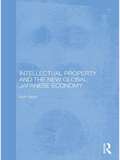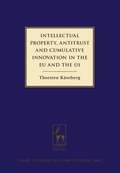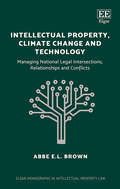- Table View
- List View
Intellectual Property and the Design of Nature
by Jose Bellido Brad ShermanIntellectual property law has been interacting with nature for over two centuries. Despite this long history, this relationship has largely been ignored. Intellectual Property and the Design of Nature fills this gap by bringing together scholars from different disciplines to examine the important role that nature plays in intellectual property law. Based on the idea that many contemporary issues require a better understanding of these historical interactions, the book reflects on the ways intellectual property law has engaged with and understood nature in the past. The varied contributions show how the relationship between nature and intellectual property law is often more complex, permeable, and porous than is commonly recognized. Intellectual Property and the Design of Nature demonstrates the complex and changing role that nature has played in the history of intellectual property law. Each of the chapters casts a new light on these connections. A compelling read for everyone interested in exploring new perspectives in the field of intellectual property.
Intellectual Property and the Design of Nature
Intellectual property law has been interacting with nature for over two centuries. Despite this long history, this relationship has largely been ignored. Intellectual Property and the Design of Nature fills this gap by bringing together scholars from different disciplines to examine the important role that nature plays in intellectual property law. Based on the idea that many contemporary issues require a better understanding of these historical interactions, the book reflects on the ways intellectual property law has engaged with and understood nature in the past. The varied contributions show how the relationship between nature and intellectual property law is often more complex, permeable, and porous than is commonly recognized. Intellectual Property and the Design of Nature demonstrates the complex and changing role that nature has played in the history of intellectual property law. Each of the chapters casts a new light on these connections. A compelling read for everyone interested in exploring new perspectives in the field of intellectual property.
Intellectual Property and the Judiciary (European Intellectual Property Institutes Network series)
by Christophe Geiger Craig A. Nard Xavier SeubaIntellectual Property and the Judiciary examines the role of judges in the development, interpretation and application of intellectual property (IP) law and norms. In this regard, the authors engage in a comparative analysis of various national, European and international court systems while also exploring the competing and complementary roles of legislators and executive actors. Each chapter seeks to capture the comparative institutional advantages of government bodies within existing legal frameworks as well as offering a thorough examination of both the common law and civil law traditions in the context of judicial treatment of intellectual property. The result is a series of proposals relating to the architecture of judiciaries and the functional role of judges with the goal of optimally positioning jurists to address complex issues and advance intellectual property doctrine and policy. Featuring high-level authors from both academia and practice, the book will be of great interest to academic researchers and practicing lawyers who have a focus on intellectual property. It will be of particular value to those who are engaged in the rapidly changing enforcement environment of intellectual property rights.
Intellectual Property and the New Global Japanese Economy (Routledge Studies in the Growth Economies of Asia)
by Ruth TaplinThe Japanese economy is the second largest in the world and is becoming once more one of the most competitive. Despite the stagnation and deflation experienced during the 1990s, Japan has progressively become more aware of the need to be a global player, in particular under the radical administration of former Prime Minister Koizumi. A vigorous approach to intellectual property borrowed from the US and Europe, stressing the importance of innovation, assisted in kick-starting the Japanese economy again and has sustained its increasingly high performance. This book examines how Japan has used this new approach to intellectual property (IP) to revitalise its economy. It explains how IP has traditionally been used in Japan, and goes on to identify the ways in which this has changed in recent years, identifying the different facets of IP utilised to propel the Japanese economy to new heights: Firstly, by promoting IP through Technical Licensing Organisations (TLO) laws and uniting the universities with the needs of industry. Secondly, via radical changes to employees’ rights to compensation through the landmark decisions made by the Tokyo District Court. Thirdly, by the streamlining of patenting applications and procedures through the Tokyo and Osaka District IP Courts, and the Japanese Patent Office. Fourthly, by internationalising its capital markets, as displayed by the cooperation between the Tokyo Stock Exchange and the London Stock Exchange (LSE) and other bourses. Overall, this book is essential reading for all those interested in understanding the modern Japanese economy, and how it is adapting to exploit the opportunities and challenges of an increasingly globalised world.
Intellectual Property and the New Global Japanese Economy (Routledge Studies in the Growth Economies of Asia #Vol. 87)
by Ruth TaplinThe Japanese economy is the second largest in the world and is becoming once more one of the most competitive. Despite the stagnation and deflation experienced during the 1990s, Japan has progressively become more aware of the need to be a global player, in particular under the radical administration of former Prime Minister Koizumi. A vigorous approach to intellectual property borrowed from the US and Europe, stressing the importance of innovation, assisted in kick-starting the Japanese economy again and has sustained its increasingly high performance. This book examines how Japan has used this new approach to intellectual property (IP) to revitalise its economy. It explains how IP has traditionally been used in Japan, and goes on to identify the ways in which this has changed in recent years, identifying the different facets of IP utilised to propel the Japanese economy to new heights: Firstly, by promoting IP through Technical Licensing Organisations (TLO) laws and uniting the universities with the needs of industry. Secondly, via radical changes to employees’ rights to compensation through the landmark decisions made by the Tokyo District Court. Thirdly, by the streamlining of patenting applications and procedures through the Tokyo and Osaka District IP Courts, and the Japanese Patent Office. Fourthly, by internationalising its capital markets, as displayed by the cooperation between the Tokyo Stock Exchange and the London Stock Exchange (LSE) and other bourses. Overall, this book is essential reading for all those interested in understanding the modern Japanese economy, and how it is adapting to exploit the opportunities and challenges of an increasingly globalised world.
Intellectual Property and Theories of Justice
by A. Gosseries A. Marciano A. StrowelFourteen philosophers, economists and legal scholars address the question 'Can intellectual property rights be fair?' What differentiates intellectual from real property? Should libertarians or Rawlsians defend IP rights? What's wrong with free-riding? How can incentives be taken into account by theories of justice?
Intellectual Property And Traditional Cultural Expressions In A Digital Environment (PDF)
by Christoph Beat Graber Mira Burri-NenovaIn the face of increasing globalisation, and a collision between global communication systems and local traditions, this book offers innovative trans-disciplinary analyses of the value of traditional cultural expressions (TCE) and suggests appropriate protection mechanisms for them. It combines approaches from history, philosophy, anthropology, sociology and law, and charts previously untravelled paths for developing new policy tools and legal designs that go beyond conventional copyright models. Its authors extend their reflections to a consideration of the specific features of the digital environment, which, despite enhancing the risks of misappropriation of traditional knowledge and creativity, may equally offer new opportunities for revitalising indigenous peoples' values and provide for the sustainability of TCE. This book will appeal to scholars interested in multidisciplinary analyses of the fragmentation of international law in the field of intellectual property and traditional cultural expressions. It will also be valuable reading for those working on broader governance and human rights issues.
Intellectual Property and Traditional Knowledge in the Global Economy: Translating Geographical Indications for Development (Routledge Research in Intellectual Property)
by Teshager W. DagneArising from recent developments at the international level, many developing countries, indigenous peoples and local communities are considering using geographical indications (GIs) to protect traditional knowledge, and to promote trade and overall economic development. Despite the considerable enthusiasm over GIs in diverse quarters, there is an appreciable lack of research on how far and in what context GIs can be used as a protection model for traditional knowledge-based resources. This book critically examines the potential uses of geographical indications as models for protecting traditional knowledge-based products and resources in national and international intellectual property legal frameworks. By analysing the reception towards GIs from developing countries and advocates of development in the various legal and non-legal regimes (including the World Trade Organization, World Intellectual Property Organization, and the Convention on Biological Diversity and the Food and Agricultural Organization), the book evaluates the development potential of GIs in relation to ensuing changes in international intellectual property law in accommodating traditional knowledge. Teshager W. Dagne argues for a degree of balance in the approach to the implementation of global intellectual property rights in a manner that gives developing countries an opportunity to protect traditional knowledge-based products. The book will be of great interest and use to scholars and students of intellectual property law, public international law, traditional knowledge, and global governance.
Intellectual Property and Traditional Knowledge in the Global Economy: Translating Geographical Indications for Development (Routledge Research in Intellectual Property)
by Teshager W. DagneArising from recent developments at the international level, many developing countries, indigenous peoples and local communities are considering using geographical indications (GIs) to protect traditional knowledge, and to promote trade and overall economic development. Despite the considerable enthusiasm over GIs in diverse quarters, there is an appreciable lack of research on how far and in what context GIs can be used as a protection model for traditional knowledge-based resources. This book critically examines the potential uses of geographical indications as models for protecting traditional knowledge-based products and resources in national and international intellectual property legal frameworks. By analysing the reception towards GIs from developing countries and advocates of development in the various legal and non-legal regimes (including the World Trade Organization, World Intellectual Property Organization, and the Convention on Biological Diversity and the Food and Agricultural Organization), the book evaluates the development potential of GIs in relation to ensuing changes in international intellectual property law in accommodating traditional knowledge. Teshager W. Dagne argues for a degree of balance in the approach to the implementation of global intellectual property rights in a manner that gives developing countries an opportunity to protect traditional knowledge-based products. The book will be of great interest and use to scholars and students of intellectual property law, public international law, traditional knowledge, and global governance.
Intellectual Property, Antitrust and Cumulative Innovation in the EU and the US (Hart Studies in Competition Law)
by Thorsten KäsebergFor decades, the debate about the tension between IP and antitrust law has revolved around the question to what extent antitrust should accept that IP laws may bar competition in order to stimulate innovation. The rise of IP rights in recent years has highlighted the problem that IP may also impede innovation, if research for new technologies or the marketing of new products requires access to protected prior innovation. How this 'cumulative innovation' is actually accounted for under IP and antitrust laws in the EU and the US, and how it could alternatively be dealt with, are the central questions addressed in this unique study by lawyer and economist Thorsten Käseberg.Taking an integrated view of both IP and antitrust rules – in particular on refusals to deal based on IP – the book assesses policy levers under European and US patent, copyright and trade secrecy laws, such as the bar for and scope of protection as well as research exemptions, compulsory licensing regimes and misuse doctrines. It analyses what the allocation of tasks is and should be between these IP levers and antitrust rules, in particular the law on abuse of dominance (Article 102 TFEU) and monopolisation (Section 2 Sherman Act), while particular attention is paid to the essential facilities doctrine, including pricing methodologies for access to IP.Many recent decisions and judgments are put into a coherent analytical framework, such as IMS Health, AstraZeneca, GlaxoSmithKline (in the EU), Apple (France), Orange Book Standard (Germany), Trinko, Rambus, NYMEX, eBay (US), Microsoft and IBM/T3 (both EU and US). Further topics covered include: IP protection for software, interoperability information and databases; industry-specific tailoring of IP; antitrust innovation market analysis; and the WTO law on the IP/antitrust interface.
Intellectual Property, Antitrust and Cumulative Innovation in the EU and the US (Hart Studies in Competition Law)
by Thorsten KäsebergFor decades, the debate about the tension between IP and antitrust law has revolved around the question to what extent antitrust should accept that IP laws may bar competition in order to stimulate innovation. The rise of IP rights in recent years has highlighted the problem that IP may also impede innovation, if research for new technologies or the marketing of new products requires access to protected prior innovation. How this 'cumulative innovation' is actually accounted for under IP and antitrust laws in the EU and the US, and how it could alternatively be dealt with, are the central questions addressed in this unique study by lawyer and economist Thorsten Käseberg.Taking an integrated view of both IP and antitrust rules – in particular on refusals to deal based on IP – the book assesses policy levers under European and US patent, copyright and trade secrecy laws, such as the bar for and scope of protection as well as research exemptions, compulsory licensing regimes and misuse doctrines. It analyses what the allocation of tasks is and should be between these IP levers and antitrust rules, in particular the law on abuse of dominance (Article 102 TFEU) and monopolisation (Section 2 Sherman Act), while particular attention is paid to the essential facilities doctrine, including pricing methodologies for access to IP.Many recent decisions and judgments are put into a coherent analytical framework, such as IMS Health, AstraZeneca, GlaxoSmithKline (in the EU), Apple (France), Orange Book Standard (Germany), Trinko, Rambus, NYMEX, eBay (US), Microsoft and IBM/T3 (both EU and US). Further topics covered include: IP protection for software, interoperability information and databases; industry-specific tailoring of IP; antitrust innovation market analysis; and the WTO law on the IP/antitrust interface.
Intellectual Property as a Complex Adaptive System: The role of IP in the Innovation Society (European Intellectual Property Institutes Network series)
This incisive book examines the role of Intellectual Property (IP) as a complex adaptive system in innovation and the lifecycle of IP intensive assets. Discussing recent innovation trends, it places emphasis on how different forms of intellectual property law can facilitate these trends. Inventors and entrepreneurs are guided through the lifecycle of IP intensive assets that commercialise human creativity.Utilising a range of sector-specific, interdisciplinary and actor-focused approaches, each contribution offers suggestions on how Europe’s capacity to foster innovation-based sustainable economic growth can be enhanced on a global scale. This comprehensive book addresses the role of IP in public–private partnerships and business transactions and further explores how IP law can uphold distributive justice in the innovation society. Chapters span a range of topics of great societal interest, including standard essential patent licensing in the Internet of Things, patent quality concerns under competition law and the role of market-driven and legislative solutions to online music licensing.Intellectual Property as a Complex Adaptive System will be a key resource for students and scholars of IP law, innovation and economics. It will also be vital reading for practitioners, knowledge-intensive industry representatives and innovation and technology transfer specialists.
Intellectual Property Asset Management: How to identify, protect, manage and exploit intellectual property within the business environment
by Claire Howell David BainbridgeIn the new ‘knowledge-intensive economies’ Intellectual assets increasingly play a key part on balance sheets. There is an increasing global awareness that in order to promote innovation and the growth of the economy, businesses must fully recognise and exploit their intellectual assets. A company’s ability to innovate rapidly and successfully is now regarded as essential and most breakthroughs are made by Small and Medium-sized Enterprises (SMEs), usually with no in-house legal professionals to help them. It is essential that those working with or creating intellectual property rights (IPR) are aware of the basics of Intellectual Property Law. Intellectual Property Asset Management provides business and management students at all levels with an accessible-straight-forward explanation of what the main Intellectual Property rights are and how these rights are protected. Locating the subject squarely in a business context and using case studies and examples throughout drawn from a wide range of business organisations, it explains how an organisation can exploit their rights through licensing, franchising and other means in order to make the best possible use of their IP assets. This book will provide students with:• the basic Intellectual Property law knowledge needed to identify a potential IP issue• the tools and understanding to assess an IP breach• the ability to identify where the problem cannot be solved in house and where expert legal assistance is required • the knowledge required to work effectively with lawyers and other legal professionals to achieve the desired outcome
Intellectual Property Asset Management: How to identify, protect, manage and exploit intellectual property within the business environment
by Claire Howell David BainbridgeIn the new ‘knowledge-intensive economies’ Intellectual assets increasingly play a key part on balance sheets. There is an increasing global awareness that in order to promote innovation and the growth of the economy, businesses must fully recognise and exploit their intellectual assets. A company’s ability to innovate rapidly and successfully is now regarded as essential and most breakthroughs are made by Small and Medium-sized Enterprises (SMEs), usually with no in-house legal professionals to help them. It is essential that those working with or creating intellectual property rights (IPR) are aware of the basics of Intellectual Property Law. Intellectual Property Asset Management provides business and management students at all levels with an accessible-straight-forward explanation of what the main Intellectual Property rights are and how these rights are protected. Locating the subject squarely in a business context and using case studies and examples throughout drawn from a wide range of business organisations, it explains how an organisation can exploit their rights through licensing, franchising and other means in order to make the best possible use of their IP assets. This book will provide students with:• the basic Intellectual Property law knowledge needed to identify a potential IP issue• the tools and understanding to assess an IP breach• the ability to identify where the problem cannot be solved in house and where expert legal assistance is required • the knowledge required to work effectively with lawyers and other legal professionals to achieve the desired outcome
Intellectual Property, Biogenetic Resources And Traditional Knowledge
by Graham DutfieldBiogenetic resources - the critical biological and chemical materials that underpin so much of medicine, both modern and traditional, agriculture, and wider economic activity in so many fields - are at the centre of heated debate regarding their use, development, and ownership, and the issues of ethics and equity that impinge on all of these factors. This book is a comprehensive examination of the key issues, institutions and ideologies in this area, presenting definitions and explanations of the fundamentals of intellectual property rights (IPRs), biogenetic resources and traditional knowledge. It uses the insights from this to build a picture of how these factors interact in practice, bringing to the surface issues such as: the conservation and sustainable use of biodiversity, benefit sharing from the commercial use of biodiversity, biotechnological innovation and the transfer of technology, agriculture, food security, rural development, health and international justice. Part 1 describes the relevant international IPR laws, highlights the extent to which modern commerce depends on such resources, and traces the way in which modern IPR law has evolved to accommodate this dependence. Part 2 shows how stronger IPR protection in the area of life science innovation has given rise to controversies such as 'biopiracy', 'terminator' genes and genetic uniformity. Part 3 focuses on traditional knowledge, its nature, its importance, and the applicability of IPR-style protection. Part 4 covers the international negotiation and policy-making of the WTO, WIPO and CBD and the legislative initiatives of national governments of Asia, Africa and Latin America. Finally, Part 5 focuses on two developing country case studies - of India and Kenya - assessing whether they will be able to gain economic benefit from development of their natural resources within the current regulatory system and whether this will encourage the conservation and sustainable use of the resource base. With its multidisciplinary approach and breadth of coverage, this book will appeal both to those new to the subject and to those with professional and specialist interest, including students, academics, legal practitioners, government policy-makers and the private sector.
Intellectual Property, Biogenetic Resources And Traditional Knowledge (PDF)
by Graham DutfieldBiogenetic resources - the critical biological and chemical materials that underpin so much of medicine, both modern and traditional, agriculture, and wider economic activity in so many fields - are at the centre of heated debate regarding their use, development, and ownership, and the issues of ethics and equity that impinge on all of these factors. This book is a comprehensive examination of the key issues, institutions and ideologies in this area, presenting definitions and explanations of the fundamentals of intellectual property rights (IPRs), biogenetic resources and traditional knowledge. It uses the insights from this to build a picture of how these factors interact in practice, bringing to the surface issues such as: the conservation and sustainable use of biodiversity, benefit sharing from the commercial use of biodiversity, biotechnological innovation and the transfer of technology, agriculture, food security, rural development, health and international justice. Part 1 describes the relevant international IPR laws, highlights the extent to which modern commerce depends on such resources, and traces the way in which modern IPR law has evolved to accommodate this dependence. Part 2 shows how stronger IPR protection in the area of life science innovation has given rise to controversies such as 'biopiracy', 'terminator' genes and genetic uniformity. Part 3 focuses on traditional knowledge, its nature, its importance, and the applicability of IPR-style protection. Part 4 covers the international negotiation and policy-making of the WTO, WIPO and CBD and the legislative initiatives of national governments of Asia, Africa and Latin America. Finally, Part 5 focuses on two developing country case studies - of India and Kenya - assessing whether they will be able to gain economic benefit from development of their natural resources within the current regulatory system and whether this will encourage the conservation and sustainable use of the resource base. With its multidisciplinary approach and breadth of coverage, this book will appeal both to those new to the subject and to those with professional and specialist interest, including students, academics, legal practitioners, government policy-makers and the private sector.
Intellectual Property Branding in the Developing World: A New Approach to Non-Technological Innovations (Routledge Research in Intellectual Property)
by Tshimanga KongoloIntellectual Property Branding in the Developing World identifies success stories in the areas of intellectual property (IP) and branding for non-technological innovation in the developing world. The author examines the relationship between IP, branding and innovation to demonstrate that innovation, in general, and non-technological innovation, in particular, must go hand in hand with branding. Branding of non-technological innovations should be a good strategic tool to be used by countries in the developing world mainly in the areas where they have competitive advantages. This book will assist scholars and academics dealing with innovation, branding, and IP issues, providing context and guidance to policymakers from the developing world. It is also relevant to researchers and students in the fields of intellectual property law, commercial law, international law, management, and innovation.
Intellectual Property Branding in the Developing World: A New Approach to Non-Technological Innovations (Routledge Research in Intellectual Property)
by Tshimanga KongoloIntellectual Property Branding in the Developing World identifies success stories in the areas of intellectual property (IP) and branding for non-technological innovation in the developing world. The author examines the relationship between IP, branding and innovation to demonstrate that innovation, in general, and non-technological innovation, in particular, must go hand in hand with branding. Branding of non-technological innovations should be a good strategic tool to be used by countries in the developing world mainly in the areas where they have competitive advantages. This book will assist scholars and academics dealing with innovation, branding, and IP issues, providing context and guidance to policymakers from the developing world. It is also relevant to researchers and students in the fields of intellectual property law, commercial law, international law, management, and innovation.
Intellectual Property, Climate Change and Technology: Managing National Legal Intersections, Relationships and Conflicts (Elgar Monographs in Intellectual Property Law)
by Abbe E.L. BrownExploring the potential for alignment as well as conflicts between IP and climate change, Intellectual Property, Climate Change and Technology encourages a coherent and integrated approach to decision making. This groundbreaking book identifies and challenges the lack of intersection between intellectual property law and climate change law at national level. It argues that intellectual property confers private rights on the results of innovation and creativity, while climate change law and policy exists more in the public sphere without engagement with intellectual property, with no space for the conflict between this private power and public goal to be investigated in litigation. This thought-provoking book will be of great interest to scholars working in the fields of IP, climate change law, human rights, investor–state dispute settlement, and planning and sustainable development, challenging the assumption that some problems are dealt with only through consideration of certain areas of the law. Proposing new processes for policy and law making in order to remove barriers between these fields, Intellectual Property, Climate Change and Technology will also be a valuable resource for members of parliament and policy makers.
Intellectual Property, Competition Law and Economics in Asia
by R Ian McEwinThis book results from a conference held in Singapore in September 2009 that brought together distinguished lawyers and economists to examine the differences and similarities in the intersection between intellectual property and competition laws in Asia. The prime focus was how best to balance these laws to improve economic welfare. Countries in Asia have different levels of development and experience with intellectual property and competition laws. Japan has the longest experience and now vigorously enforces both competition and intellectual property laws. Most other countries in Asia have only recently introduced intellectual property laws (due to the Trade-Related Aspects of Intellectual Property Rights (TRIPS) Agreement) and competition laws (sometimes due to the World Bank, International Monetary Fund or free trade agreements). It would be naïve to think that laws, even if similar on the surface, have the same goals or can be enforced similarly. Countries have differing degrees of acceptance of these laws, different economic circumstances and differing legal and political institutions. To set the scene, Judge Doug Ginsburg, Greg Sidak, David Teece and Bill Kovacic look at the intersection of intellectual property and competition laws in the United States. Next are country chapters on Asia, each jointly authored by a lawyer and an economist. The country chapters outline the institutional background to the intersection in each country, discuss the policy underpinnings (theoretically as well as describing actual policy initiatives), analyse the case law in the area, and make policy prescriptions.
Intellectual Property, Competition Law and Economics in Asia
by R Ian McEwinThis book results from a conference held in Singapore in September 2009 that brought together distinguished lawyers and economists to examine the differences and similarities in the intersection between intellectual property and competition laws in Asia. The prime focus was how best to balance these laws to improve economic welfare. Countries in Asia have different levels of development and experience with intellectual property and competition laws. Japan has the longest experience and now vigorously enforces both competition and intellectual property laws. Most other countries in Asia have only recently introduced intellectual property laws (due to the Trade-Related Aspects of Intellectual Property Rights (TRIPS) Agreement) and competition laws (sometimes due to the World Bank, International Monetary Fund or free trade agreements). It would be naïve to think that laws, even if similar on the surface, have the same goals or can be enforced similarly. Countries have differing degrees of acceptance of these laws, different economic circumstances and differing legal and political institutions. To set the scene, Judge Doug Ginsburg, Greg Sidak, David Teece and Bill Kovacic look at the intersection of intellectual property and competition laws in the United States. Next are country chapters on Asia, each jointly authored by a lawyer and an economist. The country chapters outline the institutional background to the intersection in each country, discuss the policy underpinnings (theoretically as well as describing actual policy initiatives), analyse the case law in the area, and make policy prescriptions.
Intellectual Property Damages: Guidelines and Analysis
by Mark A. Glick Lara A. Reymann Richard HoffmanA comprehensive resource for anyone involved in intellectual property litigation With Intellectual Property Damages you'll get the basics of the intellectual property litigation process, the essential "rules" in postulating damages theories, the basics of IP law, the economic policies that are the foundation for much of IP litigation, the skills necessary to correctly calculate damages in IP cases--and more! Order your copy today!
Intellectual Property, Design Innovation, and Entrepreneurship (Springer Series in Design and Innovation #11)
by Matthias HillnerThis book focuses on intellectual property (IP) in the context of product innovation and design-led start-up management. A distinguished feature is that it analyses innovation-related scenarios within their continuously changing contexts. IP is discussed in relation to the way in which its value changes over time as a venture matures. The book reveals how IP strategies can enhance a start-up’s survival prospects and its growth potential if they are connected systematically to other business development attributes. Being mainly addressed to enterprising designers, it may also support business administration programmes, innovation hubs, design educators, incubator managers, as well as business coaches and IP attorneys who support creatives and inventors. All in all, this book offers a unique and timely strategic guidance in the field of design and innovation management. “Design and design rights have long been overlooked in the plethora of studies on the links between IPR and innovation. Matthias Hillner’s thoughtful and eloquent journey provides a contemporary and meaningful analysis which will no doubt assist governments, economists, academics and designers’ better understanding of design in the context of successful business strategies and IPR. Given design’s significant contribution to global economies, I am confident it will offer much needed guidance.”Dids Macdonald OBE, founder CEO of Anticopying in Design (ACID)"This is an immensely practical book for designers and entrepreneurs who want to understand the issues of IP, product innovation, and business development. With clear explanations, many vivid examples, and strategically useful tips, it will be a valuable resource for creative minds at all levels of experience. A serious book but written with a sensitive touch on how to protect new ideas." Richard Buchanan, Professor of Design, Management, and Innovation, Weatherhead School of Management, Case Western Reserve University
Intellectual Property Excesses: Exploring the Boundaries of IP Protection
by Enrico Bonadio and Aislinn O’ConnellThis collection of essays highlights the sometimes absurd outcomes which an unjustified overprotection of intellectual property (IP) may lead to. It collects and comments on a series of IP disputes which have taken the notion of IP protection to extremes. From individuals being sued for hundreds of thousands of dollars for sharing a playlist, to sports spectators being arrested for wearing the 'wrong' dresses, passing through granting patents for inventions obtained by misappropriating traditional knowledge, and trademark protection of merely descriptive signs, this book brings together a broad range of examples from across the IP spectrum where protection and enforcement have been used or threatened on unreasonable and/or untenable grounds.The aim of the book is to criticise these excesses precisely because they harm IP; and because they contribute to creating an environment where more and more people are led to 'hate' IP, and view it as a protectionist regime which discourages creativity in innovation and ends up safeguarding the owners of monopolistic rights which restrict trade, competition and people's freedom.This is not, therefore, a book against IP, it is instead a call for change and an attempt to 'save' IP through critiquing its excesses and preventing such a fascinating area of law from continuing to be an easy target for criticism.The book includes a foreword by Jason Mazzone, Albert E Jenner Jr Professor of Law at the University of Illinois, USA.
Intellectual Property Excesses: Exploring the Boundaries of IP Protection
This collection of essays highlights the sometimes absurd outcomes which an unjustified overprotection of intellectual property (IP) may lead to. It collects and comments on a series of IP disputes which have taken the notion of IP protection to extremes. From individuals being sued for hundreds of thousands of dollars for sharing a playlist, to sports spectators being arrested for wearing the 'wrong' dresses, passing through granting patents for inventions obtained by misappropriating traditional knowledge, and trademark protection of merely descriptive signs, this book brings together a broad range of examples from across the IP spectrum where protection and enforcement have been used or threatened on unreasonable and/or untenable grounds.The aim of the book is to criticise these excesses precisely because they harm IP; and because they contribute to creating an environment where more and more people are led to 'hate' IP, and view it as a protectionist regime which discourages creativity in innovation and ends up safeguarding the owners of monopolistic rights which restrict trade, competition and people's freedom.This is not, therefore, a book against IP, it is instead a call for change and an attempt to 'save' IP through critiquing its excesses and preventing such a fascinating area of law from continuing to be an easy target for criticism.The book includes a foreword by Jason Mazzone, Albert E Jenner Jr Professor of Law at the University of Illinois, USA.















